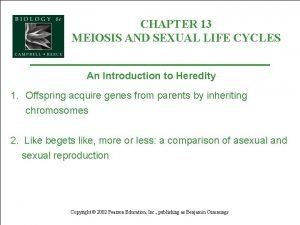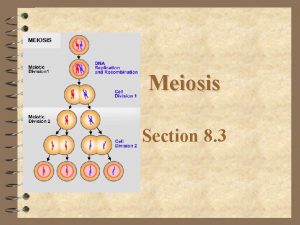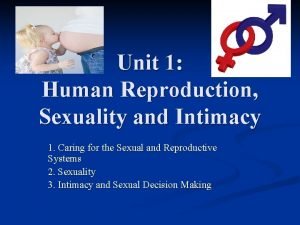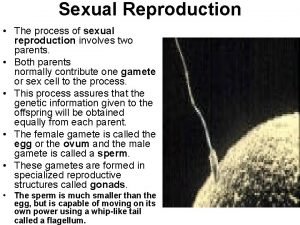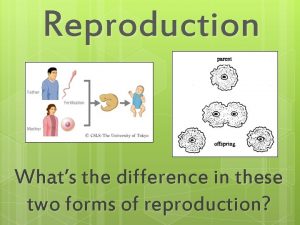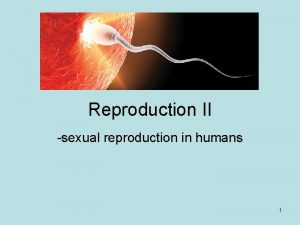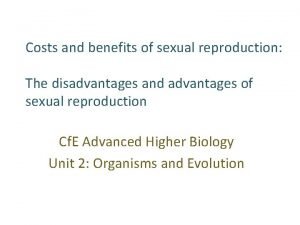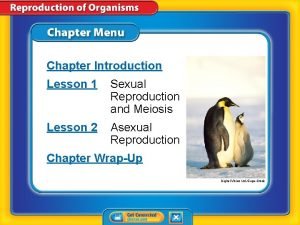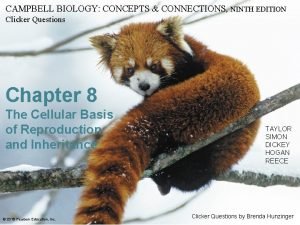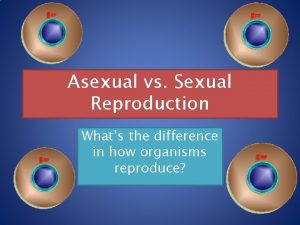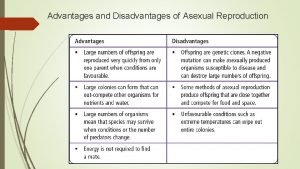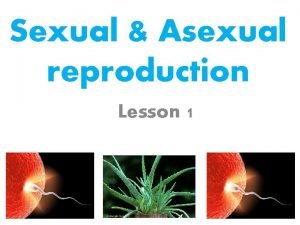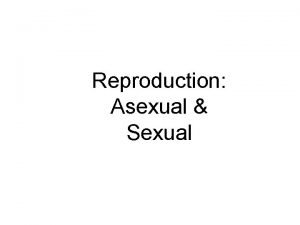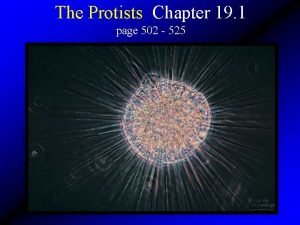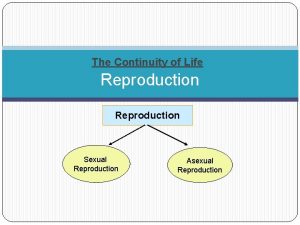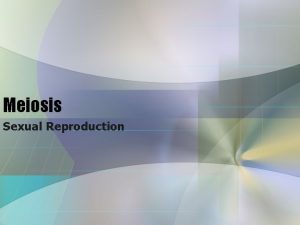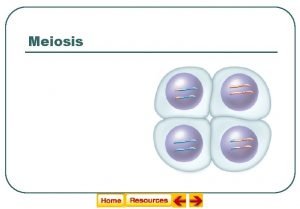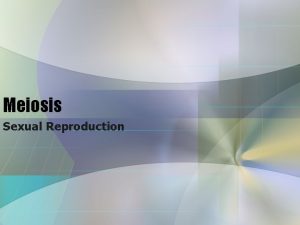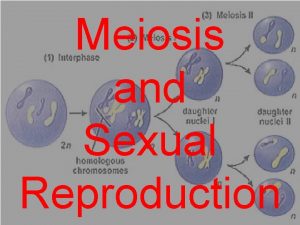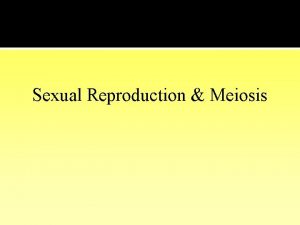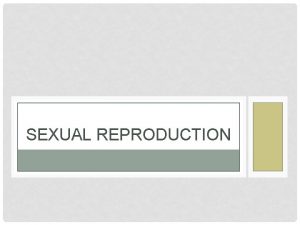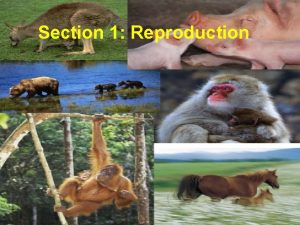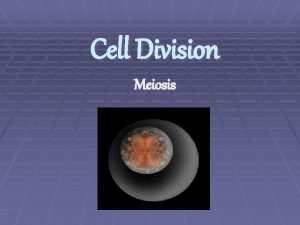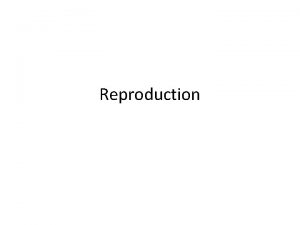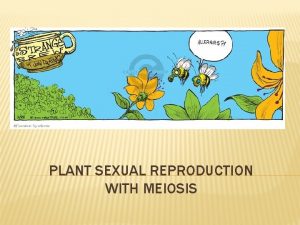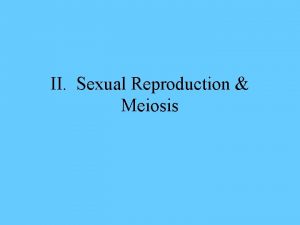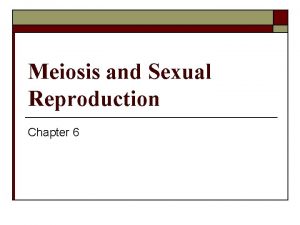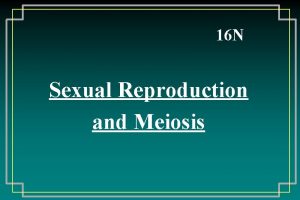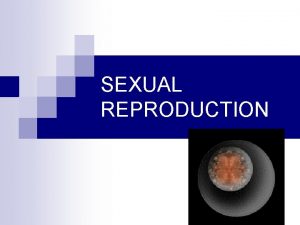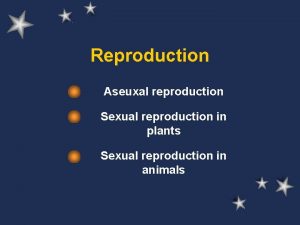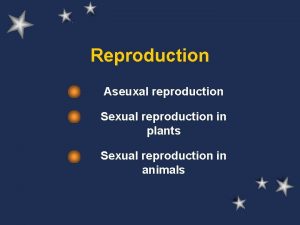Meiosis Sexual Cell Reproduction Sexual Cell Reproduction All



































- Slides: 35

Meiosis Sexual Cell Reproduction

Sexual Cell Reproduction • All living cells arise from pre-existing cells, tracing the lineage of every living things back to some primordial ancestor. If mitosis were the only process involved the production of new cells, then all cells would be exactly the same. • Instead, there exists an incredible variety among organisms

Gametes and the Life Cycle of a Sexual Organism Egg cell • The life cycle of a multicellular organism is the sequence of stages leading from the adults of one generation to the adults of the next Sperm cell Meiosis Fertilization Multicellular diploid adults (2 n = 46) Diploid zygote (2 n = 46) Mitosis and development Figure 8. 13

DNA Sequence • It is the sequence of the bases in a gene that holds the genetic code • And therefore holds the code for all cellular processes and the variety of inherited traits we see in organisms

Meiosis The cellular bases for sexual reproduction -the mixing of genetic traits produces offspring different from each parent - Fertilization requires 2 gametes (egg and sperm) -These gametes contain ½ the genetic information - Each sperm or egg produced carries 1 of over 8 million possible combinations of parental 2 n 46 chrom 2 n 2 n (46) n n 23 23

Meiosis versus Mitosis 3 Important Differences: 1. Takes place in 2 stages involving 2 successive divisions 2. The chromosomes arrange themselves in homologous pairs (pair up with another chromosome of the same size and shape) 3. Therefore, the four daughter cells are not necessarily identical and have only ½ the number of chromosomes present in the original parent cell.

Meiosis • The production of gametes with half the number of chromosomes as the original “parent” cell • During this process specialized cells in the gonads (ovary & testes), produce sex cells that contain only one set of chromosomes. • A human germ cell with 46 chromosomes will undergo meiosis and produce gametes that have 23 chromosomes

Meiosis • The 46 chromosomes number is referred to as diploid and is written as 2 n • The 23 chromosomes number is referred to as haploid and is written as n • Fertilization occurs when 2 gametes (sperm & egg) fuse, forming a diploid zygote (46 chromosomes) Sperm Egg 23 Chromosomes (haploid) 23 chromosomes (haploid) Zygote 46 chromosomes (diploid)

Each chromosome has a partner • Keep in mind that the 23 chromosomes are not just any 23, but one member from each pair. • Each of the 23 chromosomes that you receive from your father is matched by 23 chromosomes from your mother • Example: Your father gives you a chromosome with genes that code for eye colour and so does your mother

Homologous Chromosomes • The paired chromosomes are called homologous chromosomes • Homologus Pairs = a pair of chromosomes that have similar lengths, shapes and carry genes controlling the same traits • However each chromosome does not necessarily carry the same genetic information For example: both chromosomes in a homologous pair may carry a gene for eye colour but one may code for blue and the other for brown eyes • Each cell produced during meiosis contains one member from each pair of homologous chromosomes After DNA replication

Phases of Meiosis • • • Meiosis I Interphase Prophase I Metaphase I Anaphase I Telophase I • • Meiosis II Prophase II Metaphase II Anaphase II Telophase II

Meiosis • Meiosis involves 2 cell divisions that produces 4 haploid cells • To keep things simple, in our example we will use cells that contain 2 n=4 chromosomes. • Therefore, the cell will contain two pairs of homologous chromosomes.

Interphase • As in mitosis, interphase (cell growth and DNA replication), must occur before cell can replicate • Very important = interphase occurs before prophase I but not before prophase II Chromatin Centriole s

Interphase: DNA replication of homologous pairs Replication

Prophase 1 1. Chromatin coils tightly to form chromosomes - DNA has already replicated 2. Homologous chromosomes pair up side by side in a process called synapsis. - When 2 homologous chromosomes are paired, the structure is called a bivalent ( = 2 chromosomes) Paternal Homolog Maternal homolog

Prophase 1 3. Chromosomes shorten & thicken - the homologous chromosomes (bivalents) pair up to form tetrads. • Each tetrad contains 2 homologous chromosomes and 4 Tetrad chromatids

Crossing Over • As the homologous chromosomes come close together, they often intertwine • Sometimes chromatids break & exchange segments. This process is called crossing over The area(s) where the chromatids overlap is called a chiasma Here homologous chromosomes exchange genetic material

Crossing Over This leads to enormous genetic variation even between siblings • There are over 8 million possible combinations of parental chromosomes 5. The chiasma begins to disappear The nuclear membrane disintegrates **In females this is where meiosis stops until puberty (Prophase I)

Prophase I : 2 n = 6 or n=3 • Draw a germ cell in prophase I Homologous • Label: pair 1. Homologous chromosomes & tetrad 2. Nuclear membrane 3. Centrioles, astral rays Tetrad

Metaphase I • The tetrads line up on the equatorial plate Metaphase plate • The homologous pairs line up randomly • There is a 50 -50 chance for the daughter cells to get either pair from each chromosome. You could get this one or that one Centriole


• Spindle fibres attach to the centromeres of the chromosomes • Each pair of sister chromatids from each homologous chromosome is ready to move to opposite poles of the cell Draw a diagram

Anaphase I • Homologous chromosomes separate and move to opposite poles • This process is known as segregation – the separation of paired genes • At this point, reduction division has occurred! • Each chromosome remains double stranded

Draw a diagram

Telophase I • Cytoplasm divides = Cytokinesis • A nuclear membrane begins to form • Chromosomes unwind into chromatin • The two new daughter cells contain 2 chromosomes each. Two haploid cells (cells with half the chromosome number) start to form. Chromosomes are half the number, but still double stranded.

Draw a diagram • Label the following: 1. Cleavage furrow 2. Daughter cells 3. Nuclear membrane 4. Chromatin

Meiosis I versus Mitosis • The first division is different from mitosis because the daughter cells are not identical • Each daughter cell contains 1 member of the chromosome pair • Remember homologous pairs are similar but they are not identical

Meiosis II ****The short phase between Meiosis I and II is referred to as interkinesis There may or may not be an interphase II depending on species • The next set of cell divisions • Begin with the 2 daughter cells from meiosis I will separate the chromatids • DNA replication does NOT occur • Nuclear membrane dissolves, spindle fibres form Prophase II

Draw a diagram

Metaphase II • The chromosomes , each with two sister chromatids, align on the equatorial plate • The centromeres attach to spindle fibres

Anaphase II • The centromeres separate and chromatids move towards opposite poles

Telophase II • 4 new cells will be formed Each of the new cells will contain only one member from each homologous pair = haploid (n) • The parent cell had 6 chromosomes; the daughter cells have 3 chromosomes each

Meiosis Summary • The haploid cells complete the meiotic cycle and differentiate to produce gametes (egg & sperm) Important to remember: -Meiosis I is referred to as reductional division because the chromosome number is reduced by half - Meiosis II is called equational division and is similar to mitosis as centromeres on sister chromatids separate and chromosome number remains unchanged

Meiosis I MEIOSIS I: Homologous chromosomes separate INTERPHASE Centrosomes (with centriole pairs) Nuclear envelope PROPHASE I Sites of crossing over Spindle Chromatin Sister chromatids Tetrad METAPHASE I Metaphase plate ANAPHASE I Sister chromatids remain attached Homologous chromosomes separate

Meiosis II MEIOSIS II: Sister chromatids separate TELOPHASE I & CYTOKINESIS PROPHASE II METAPHASE II ANAPHASE II Sister chromatids separate TELOPHASE II & CYTOKINESIS Haploid daughter cells forming
 Sexual reproduction and genetics section 1 meiosis
Sexual reproduction and genetics section 1 meiosis Chapter 10 section 3 gene linkage and polyploidy
Chapter 10 section 3 gene linkage and polyploidy Asexual reproduction cell division
Asexual reproduction cell division Asexualk
Asexualk Sexual vs asexual reproduction venn diagram
Sexual vs asexual reproduction venn diagram Phases of meiosis
Phases of meiosis Meisis 1 and 2
Meisis 1 and 2 Meiosis and genetic variation answer key
Meiosis and genetic variation answer key Chromosome disability
Chromosome disability Chapter 10 section 1 meiosis
Chapter 10 section 1 meiosis Chapter 10 meiosis 1 and meiosis 2 answer key
Chapter 10 meiosis 1 and meiosis 2 answer key Image of prophase 2
Image of prophase 2 Chapter 13 meiosis and sexual life cycles
Chapter 13 meiosis and sexual life cycles Chapter 13 meiosis and sexual life cycles
Chapter 13 meiosis and sexual life cycles Section 8-3 meiosis
Section 8-3 meiosis A sexual reproduction in humans
A sexual reproduction in humans Chapter 20 sexual reproduction in animals packet answers
Chapter 20 sexual reproduction in animals packet answers Sexual reproduction
Sexual reproduction Define sexual reproduction
Define sexual reproduction Whats asexual reproduction
Whats asexual reproduction Reproduction in humans
Reproduction in humans Mendelian genetics
Mendelian genetics Disadvantage of sexual reproduction
Disadvantage of sexual reproduction Connecting the concepts sexual reproduction
Connecting the concepts sexual reproduction Asexual reproduction cell division
Asexual reproduction cell division Biology
Biology Whats asexual reproduction
Whats asexual reproduction Sexual reproduction examples
Sexual reproduction examples Disadvantages of sexual reproduction
Disadvantages of sexual reproduction Mitosis vs meiosis
Mitosis vs meiosis Significance of sexual reproduction
Significance of sexual reproduction Asexual or sexual reproduction
Asexual or sexual reproduction Asexual and sexual reproduction venn diagram
Asexual and sexual reproduction venn diagram Venn diagram sexual and asexual
Venn diagram sexual and asexual Chapter 19 protists study guide answers
Chapter 19 protists study guide answers Sexual or asexual reproduction
Sexual or asexual reproduction













